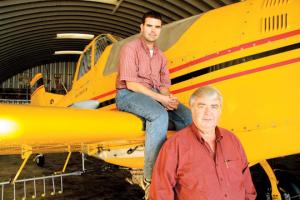Allen Chorman has a unique perspective on Sussex County. Since the late 1960s, he’s seen it from the cockpit of his crop duster, cruising over a patchwork of farms and forest before swooping in to mist acres of crops in pesticides.
“I look down there, and I don’t see anything I’d rather be doing,” Allen said. At 64, he still has a head full of not-quite-gray hair. He speaks slowly, with a Sussex melody. Sitting in the kitchen next to his Greenwood airstrip, Chorman said he doesn’t really have any hobbies – anything he could ever want to do is out there, he said, gesturing behind him where many of the company’s 15 aircraft sat in hangars.
Allen’s aircraft, a Thrush, has wide, squarish wings, a peaked cockpit and a massive, 1,000-pound radial engine snarling out front. From March to December, Allen wakes at 4 most mornings, gives his Thrush a thorough inspection and fills it up with more than 300 gallons of pesticide cocktail, specially mixed for that morning’s field.
Jeff, Allen’s son and business partner, has been waking up at the crack of dawn since he was a teenager. That’s when the air is most cooperative, Jeff said, still and crisp, making it easy to lay down an even blanket over a field of soybeans.
“Even this time of year, I get up at 4,” Jeff said. In an echo of his father, he adds, “All I ever wanted to do was fly a spray plane.”
During the summer, heat, humidity and high winds can make long days even longer; these conditions mean the Chormans fly closer to the crops, landing gears passing less than two feet over the leafy acres. At that altitude, wind isn’t the only hazard. While pulling up from a run, Allen said, pilots can be jolted by a sudden crack as their prop cuts through a power line they didn’t know was there.
“We call them sleeper wires,” Allen says with a rueful grin. Because the cables are often too fine for a pilot to discern, he said, spray pilots steer clear of the poles. But sometimes the poles are embedded in woods that hide a nasty surprise.
“I’ve hit four in my lifetime,” Allen said. “Plus or minus two.”
Allen credits his son with taking the business beyond Sussex County, expanding it fivefold with contracts all over the Delmarva Peninsula. On their busiest days, the Chormans, along with pilots Blair Thompson and Mark Greenly, land and take off from satellite strips in Roxana and Milton, as well as three strips on Maryland’s Eastern Shore. Allen’s longest day lasted 14 hours; Jeff once chalked up 18 in a single shift.
Flying is the fun part; it’s as easy as wearing a jacket, Jeff said. The real work lies in the endless minutiae of running a successful business – lining up jobs, ordering chemicals and finding the thousands of nuts, bolts and screws necessary to keep the fleet in peak condition.
Allen hastens to point out not a single prop would spin at Chorman Airfield without the dedication of the world’s best ground crew, a crack cadre of mechanics, chemical mixers and organizational geniuses who spend their days clambering over aircraft, soldering wires or tanking up planes and getting pilots back in the air.
Jeff has also taken the company beyond crop spraying. He routinely flies officials with the Department of Natural Resources and Environmental Control over Prime Hook National Wildlife Refuge for waterfowl counts; he also takes them 25 miles offshore for artificial reef assessments. He recently bought the company’s first helicopter, a tiny craft reminiscent of M.A.S.H. It’s equipped with spray booms that extend from its cockpit like whiskers.
With a bigger area of operations, technology has entered the cockpit in a way unimaginable to Allen when he started flying in 1966. Back then, fields were scouted in advance with a pick-up truck; these days, Jeff looks up unfamiliar terrain on Google Earth. If there are unforeseen complications, like laborers in the field, Jeff can call the farmer from a cell phone wired into his helmet.
Other signs of the times are less welcome: Over the years, Chorman said, he’s watched open space disappear from beneath his wings. He remembered soybean fields that once stood on the land near the intersection of Route 9 and Minos Conaway Road; now, the land has been developed into neighborhoods.
“A lot of good farmland has been ruined by greedy people,” he said. “Starting at Five Points, all the way to Rehoboth. We sprayed that ground all the time. Best farmland in the state – nice, heavy soil.”
Jeff said he remembers watching his father spray fields where Tanger Outlets now stand. Agricultural pilots have an intimate bond with the land they spray, he said. You get to know the farmers, their families and the surrounding land. Farmers grow attached to their pilots and vice versa.
“People say the ag pilots or farmers or whoever aren’t environmentalists,” he said. “We’re the first environmentalists. There’s nothing more important than the peninsula or our environment. Anybody can pay their dues and say they’re part of Green Peace; we’re out here living and working every day.”
Chorman planes don’t just spray pesticides, Jeff said. Sometimes, the tanks are topped off with a green, soupy mixture of potato nutrients. Sometimes, they scatter seeds. “We’re honored to be a part of the farming community,” said Jeff. His father nodded.
“Farmers are some of the best people in the world,” Allen said solemnly. “Good, honest people.”
Allen said he used to get irate calls from people claiming to have been sprayed or woken up by the drone of his radial engine. They get fewer complaints these days – he chalks it up to nostalgia. The sound of his engine, or the flash of a yellow wingtip above the tree line, means that someone in Sussex County is still working the land, and a way of life lives on.























































